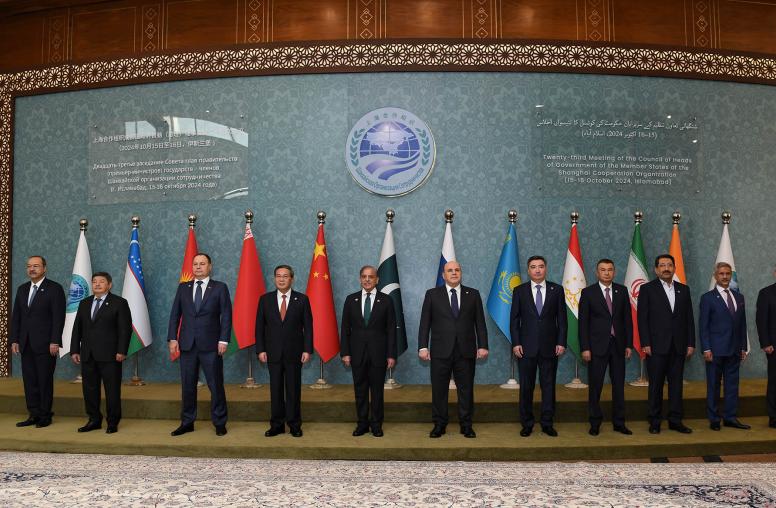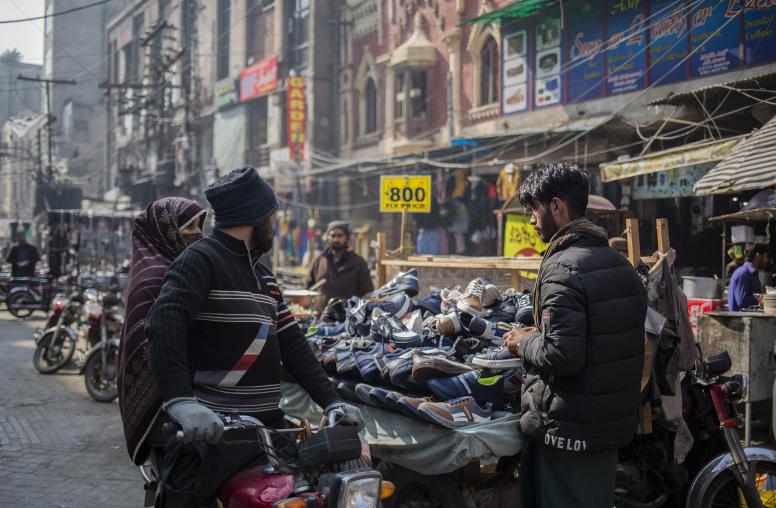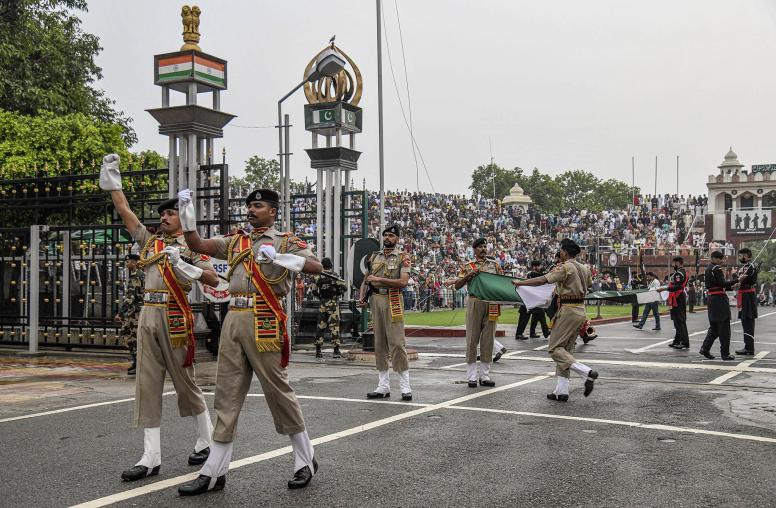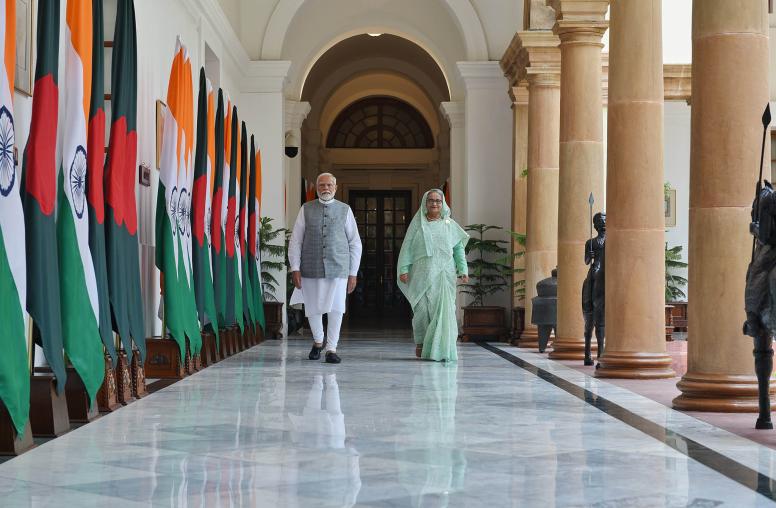The Cross-Border Dialogue Initiative empowers border communities to solve their own problems non-violently and to advocate for their own needs and aspirations non-violently with their own governments and with international actors.
Top Photo: Academy staff is providing guidance to the thematic experts, professors from the University of Peshawar and the University of Nangahar, who assisted participants to craft their policy recommendations in ways that would be useful to policy makers and international donors.
The Pashtun tribal communities along the border of Afghanistan and Pakistan are among the most-conflict affected in the world today. The populations of these regions were on the frontlines of the Cold War and they are on the frontlines of the global war on terror today. In addition, they are afflicted by long-standing tribal conflicts that are both aggravated by and contribute to national, regional, and global conflicts, as the parties to tribal conflicts attempt to manipulate and are manipulated by external forces. Finally, they are marginalized within the polities and economies of their own countries, but have often responded to their marginalization in ways that have been counter-productive. The Cross-Border Dialogue Initiative aims to empower border communities to solve their own problems non-violently and to advocate for their own needs and aspirations non-violently with their own governments and with international actors.
The Cross-Border Dialogue Initiative is a collaborative effort of the United States Institute of Peace (USIP), led by Senior Program Officer Mary Hope Schwoebel and supported by Senior Program Officer Keith Bowen, the Welfare Association for the Development of Afghanistan (WADAN), and the Sustainable Peace and Development Organization (SPADO). The Initiative was launched in January 2010. Its culmination of the first phase of the initiative were two national conferences in Kabul and Islamabad in January and February 2011. The Cross-Border Dialogue Initiative is funded by the United States Agency for International Development through an interagency transfer.
The overarching goals of the Initiative:
- To empower marginalized border communities in Afghanistan and Pakistan who are in the cross-fire of local, national, and global conflicts, to address cross-border issues at the local level utilizing local resources wherever and whenever possible.
- To empower border communities of Afghanistan and Pakistan to constructively articulate their needs and aspirations to their own local and national government officials and institutions and to international officials and organizations.
- To assist local, national and international governments to develop informed policies, programs and projects to effectively address cross-border issues based on the genuine needs and aspirations of border communities in Afghanistan and Pakistan.
The specific objectives:
- To carry out a cross-border dialogue process to identify the priority issues and common concerns of communities on both sides of the border.
- To identify and support interventions that communities can undertake themselves.
- To build the capacity of local facilitators to conduct community dialogues through training, coaching, mentoring and hands-on experience.
- To build capacity in negotiation and policy advocacy so that communities can interact constructively and non-violently with relevant local, national and international policy makers.
- To inform each government’s national and foreign policies and programs and international policies and programs related to the priority issues of border communities.
-
To enhance the knowledge of the international community about how to carry out multi-sectoral cross-border dialogue processes.
|
|
| Academy staff with some of the women dialogue participants. The women participants ensured that women’s needs and interests were included in the policy recommendations that participants presented to policy makers and international donors. |
The People
The participants in the Cross-Border Dialogue Initiative involved all segments of the population in the tribal regions along the borders of Afghanistan and Pakistan, including mullahs, maliks, academics, civil society, media, traders, businesspeople, and local government officials.The participants for each of the dialogues were selected through a rigorous and collaborative process involving country teams comprised of the USIP Afghan and Pakistani Peacebuilding Officers and USIP's local partners WADAN and SPADO, respectively according to a set of specific criteria. A list of key organizations and key individuals for each sectoral category was then generated and reviewed by the country teams. The USIP Peacebuilding Officers then reviewed the entire list to ensure balance according to tribe and clan identify, geographical origin, political affiliation, and religious persuasion,. It was essential that there was a diversity of participants, that all constituencies were represented, and that all participants were individuals who would contribute constructively to the dialogues. Altogether more than 75 individuals participated in the dialogues, while approximately 250 individuals participated in the conferences.
The facilitators for the dialogues were selected during the first cross-border activity, which was a training workshop in dialogue facilitation, which took place in Murree, Pakistan in February 2010. This activity brought together twelve facilitators from the Afghan Facilitators’ Network and twelve facilitators from the Pakistani Facilitators' Network.
The criteria for the facilitators selected from the Networks included, fluency in Pashto and knowledge of and experience in the border regions of their respective countries. Facilitators were also selected with the goal of diversity in terms of age, geographical origin, gender, and formal and informal roles in their communities. This was critical because the dialogue participants themselves represented the diverse sectors in their communities. It was therefore critical that the facilitators were appropriate for the dialogues they were to facilitate, while simultaneously ensuring that the dialogues were as inclusive as possible. For example, while half the members of the team of facilitators for the dialogues with academics, civil society and media were women, an all male team was selected for the dialogue with mullahs and maliks.
The Process
The Cross-Border Dialogue Initiative involved six distinct components. The first was capacity building in dialogue facilitation. The second was sectoral dialogues, the third was multi-sectoral dialogues, the fourth was capacity building in policy advocacy, the fifth was grassroots community dialogues, and the sixth were national conferences. The first three sectoral dialogues took place in Jalalabad, Afghanistan in April 2010. Each dialogue employed a team of four facilitators, two from each country, and each had 24 participants, 12 from each country. Because the participants in these dialogues were grouped according to sectors, these were referred to as the sectoral dialogues. The participants in the first dialogue were mullahs and maliks, in the second dialogue, participants were nongovernmental organizations, academics and members of the media, and in the third were traders, businesspeople and local government officials. A total of 15 priority issues were identified at these dialogues and action plans were developed for activities that could be undertaken by participants in their own communities utilizing available resources.
The second two dialogues took place in Kabul and in Murree, in June and in September, respectively. There was a delay in the second dialogue due to the flooding in Pakistan. These were referred to as the multi-sectoral dialogues, because the twenty-four participants were four individuals from each country from each of the three sectoral dialogues. These participants were selected based on their commitment to the process and their constructive contributions to the sectoral dialogues. At the first multi-sectoral dialogue participants reached a consensus about which of the original 15 priority issues were the three to be addressed at the national conferences. These were education, employment and livelihoods, and peacebuilding. They also developed an action plan for conducting further research related to the three issues that involved both compiling existing documentation and conducting community dialogues at the grassroots level. These grassroots dialogues were supported by USIP micro-grants and reinforced the capacity-building aspect of the initiative by providing facilitators opportunities to conduct dialogues in their own communities. At the second multi-sectoral dialogue participants presented the findings of their research and identified and developed their policy recommendations related to the three issues or themes. Participants also had the opportunity to work with thematic experts from local universities in crafting and presenting policy recommendations to policymakers.
|
|
| At the conclusion of each dialogue, the host country participants presented traditional local gifts to their visiting country counterparts. In this photo an Afghan facilitator presents an Afghan carpet to a Pakistani facilitator in Jalalabad. |
The Outcomes and Impacts
The outcomes of the conferences involved three components: capacity-building, relationship building, network building, and policy-related research findings and recommendations disseminated to local and national governments as well as to members of the international community based in Afghanistan and Pakistan. An additional outcome, which is currently in progress is publication and dissemination of findings and recommendations to the international policy community.
The capacity-building outcomes began with training of the facilitators and the learned gained from the experience of facilitating the sectoral and multi-sectoral dialogues and the grassroots community dialogues. All of the participants capacity was increased through the training in negotiation and advocacy, through the process of guided desk and field research, and the experience of generating policy recommendations and designing and delivering effective presentations to policy-makers.
The relationship building outcomes of the dialogues were experienced by the participants throughout the dialogues. It began by building relationships between the Afghan and Pakistani facilitators at the training where the facilitators were paired as roommates and later through working together on joint Afghan and Pakistani facilitation teams. The Afghan and Pakistani participants were also paired as roommates. At the end of each dialogue traditional gifts from the host country were presented by the facilitators and participants and partner staff from that country to their counterpart from the visiting country. For example, the Afghans presented the Pakistani men with Afghan turbans at the end of the dialogues in Jalalabad, while the women received Afghan dresses. Each dialogue ended with an evening of Pashtun poetry in which the participants from both sides of the border took turns reciting poetry.
As the dialogue initiative processed, the circle widened to include more participants from both sides of the border, such as the thematic experts from the University of Nangahar and the University of Peshawar. Finally, for most of the participants the national conferences were the first time they had had an opportunity to communicate with and network with their government representatives and members of the international community. Throughout the conferences there were ongoing backstage conversations between participants and conference attendees. Finally, the relationship building was not only between the Afghan and Pakistani participants, but extended to the residents of the tribal regions on both sides of the border and United States.
As one participant wrote, “We thought Americans were only interested in war. Now we know you are also interested in peace.”
All of the government officials and international donors requested copies of the participants’ presentations to utilize in their planning processes. The Deputy Minister of Education announced that he would implement all of the participants’ recommendations. The representatives from the Japanese High Commission states that they were seeking to invest in development in the Federally Administered Tribal Areas (FATA) in Pakistan and the participants’ recommendations would serve as guides for what they would invest in.
A USAID representative, the donor for the Cross-Border Dialogue Initiative, stated that he had been under pressure to show results for their investments in FATA and that the initiative provided them with results that they could show. In addition, representatives from the Canadian High Commission, who oversee the Dubai Process, a Canadian led bi-lateral process related to border issues between Afghanistan and Pakistan, expressed an interest in involving the partners and participants in the Cross-Border Dialogue Initiative in the Dubai Process. They also requested that the participants’ present their recommendations to the government officials who are participating in the Dubai Process.
Following each national conference, an entire day was devoted to a triangulated evaluation process focusing on the process and the outcomes of the Cross-Border Dialogue Initiative. The evaluation process involved a questionnaire, one on one interviews, and group discussions. When the questionnaires, essays, and flip-chart responses generated by the evaluation process are translated from Pashto into English, USIP will report further on the outcomes. In June 2011, an impact evaluation will be conducted, and USIP will produce a final report on the impacts of the Cross-Border Dialogue Initiative.





